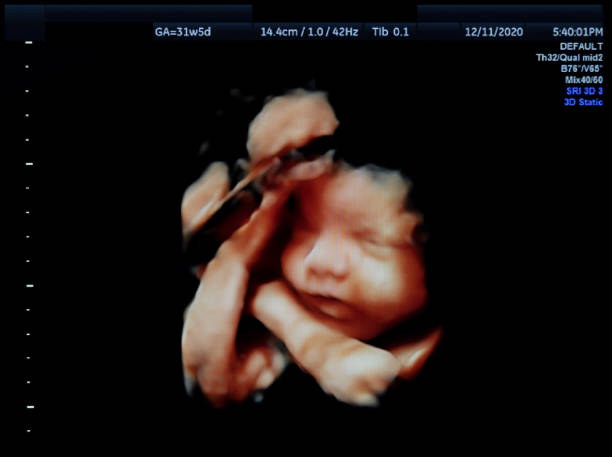Pregnancy involves a great deal of anticipation. You are interested in both the appearance and, more importantly, the health of your unborn child. An ultrasound gives you a sneak view into the womb and the opportunity to discover more about your unborn child’s health and due date.
What Is An Ultrasound?
Most pregnant women can get an ultrasound, often known as a sonogram, as a prenatal test. It displays a picture of your unborn child in the womb using sound waves. Your doctor can monitor your baby’s health and development via ultrasound.
Pregnancy ultrasounds can be particularly memorable because it’s the first opportunity to “see” your unborn child. You might be able to view your baby’s hands, legs, and other body parts depending on when it’s due and how he is positioned. You may be able to tell if your baby’s a boy or a girl, so be sure to tell your healthcare provider if you don’t want to know!
Ultrasound During Pregnancy

Image from iStock
Your doctor may use ultrasound during pregnancy to carry out a number of procedures, such as:
- To verify (ascertain) that you are pregnant
- To monitor your child’s development and age. This aids in determining your due date for your provider.
- To assess your child’s overall growth, mobility, muscular tone, and heartbeat
- To determine whether you are carrying twins, triplets, or more (also called multiples)
- To determine whether your unborn child is lying head-first before giving birth.
- To check your uterus and ovaries (womb). Your body stores eggs in your ovaries.
How Early Can Ultrasound Detect Pregnancy?
Ultrasounds can detect pregnancy as early as 4 to 5 weeks gestation, which is about 2 to 3 weeks after a missed period. At this stage, a transvaginal ultrasound is typically performed to visualize the gestational sac, confirm the presence of an embryo, and determine the location of the pregnancy within the uterus.
However, it’s important to note that the timing of the ultrasound may vary based on factors such as the accuracy of menstrual dating and the specific circumstances of the pregnancy. If you suspect you may be pregnant, it’s best to consult with a healthcare provider who can recommend the appropriate timing for an ultrasound to confirm your pregnancy.
Ultrasound is another testing method used by your doctor. Instead of determining for sure whether your baby has a problem, screening looks to see if he or she is more likely than others to develop it. Your doctor might employ ultrasound:
1. To check for birth problems like heart or spina bifida.
Following an ultrasound, your doctor might recommend additional exams, referred known as diagnostic testing, to determine for certain whether your child has a birth abnormality.
A newborn can have health issues at birth known as birth defects. Birth defects alter the appearance or functionality of one or more body parts. They may affect a person’s general health, how their body develops, or how their body functions.
2. To help in the conduct of additional prenatal diagnostics, such as chorionic villus sampling (commonly known as CVS) or amniocentesis (also called amnio).
Placental cells are extracted for examination during CVS. Your baby’s placenta is a tissue that supplies nutrition. In an amnio test, cells and amniotic fluid are extracted from the sac that surrounds your unborn child.
3. To look for issues related to pregnancy, such as ectopic pregnancy, molar pregnancy, and miscarriage.
Pregnancy Ultrasound Scans from Week 1 to Birth
Ultrasound scans are a vital part of prenatal care, providing valuable insights into the development and well-being of both the mother and the baby. From the early stages of pregnancy to the final weeks, here’s a list of ultrasound scans you can expect during this remarkable journey.
-
Dating Scan (Week 6-9): Determines the estimated due date and confirms the presence of a gestational sac.
-
Nuchal Translucency (NT) Scan (Week 11-14): Screens for potential chromosomal abnormalities and measures the fluid at the back of the baby’s neck.
-
Anatomy Scan (Week 18-20): Assesses the baby’s growth, checks for any physical abnormalities, and reveals the baby’s gender if desired.
-
Growth Scan (Week 28-32): Monitors the baby’s growth, measures amniotic fluid levels, and checks the position of the placenta.
-
Doppler Ultrasound (Throughout pregnancy): Evaluates blood flow in the umbilical cord, uterus, and baby’s organs, ensuring adequate oxygenation and nutrition.
-
Third-Trimester Scan (Week 36-40): Examines the baby’s position, assesses the placenta’s function, and checks the amniotic fluid levels.
When it comes to frequency and scheduling, women with certain medical issues, such as obesity and asthma, may require fewer ultrasounds during pregnancy.
What Can You Expect During Your First Ultrasound in Pregnancy?
The “dating” or “viability” ultrasound is your first one. You’ll find out if you’re expecting one kid, twins, or more at this ultrasound, which is usually performed between 7 and 8 weeks to confirm your due date, check for a foetal heartbeat, and measure the length of the baby from “crown to rump”!
During this session, you might possibly get to see or hear your baby’s heartbeat.
This ultrasound will be especially beneficial in predicting a more precise due date if you have irregular periods or didn’t have a period after stopping birth control. Your due date is crucial because it enables your doctor to determine whether your baby’s growth is on schedule each month.
What Can You See During Your First Ultrasound?
Your foetus is just approximately two millimetres long when you are only seven or eight weeks pregnant. The dating ultrasound is carried out transvaginally so that the foetus and uterus can be seen clearly.
Transvaginal ultrasounds can be a bit unpleasant, but they are not painful because they are performed internally, literally “through the vagina.” The majority of people would agree that it seems less intrusive than a gynaecological checkup using a speculum.

Image from iStock
Your OB-Gynaecologist or the ultrasound technician will carefully place a narrow ultrasound probe just into your vagina to do this ultrasound.
A transducer is another name for the transvaginal ultrasound probe. About three millimetres in diameter, it is slightly bigger than a tampon. It will be covered by lubricant and a condom. The wand won’t get close to your cervix and won’t harm your unborn child.
For your initial ultrasound, you might be instructed to bring a full bladder. Your uterus will be in a better position for the ultrasound if your bladder is fuller.
You can also expect the following information during your ultrasound:
- Pregnancy viability
- Fetal heartbeat
- Fetal size
- Whether one or more pregnancies
Note that there are different kinds of ultrasound during pregnancy. The kind you get depends on how far along you are in your pregnancy and what your doctor is looking for. Every ultrasound makes use of a transducer, a device that emits sound waves to produce images of your baby on a computer. The following are the most typical ultrasound types:
Transabdominal Ultrasound
This is most likely the ultrasound you hear about when you are pregnant. Your healthcare professional applies a thin layer of gel to your tummy as you lay on your back on an examination table. The gel makes it easier for sound waves to travel, which improves the quality of the image.
The transducer is then moved across your abdomen. For a full bladder during the test, you might need to consume several glasses of water about two hours prior to the exam. A full bladder facilitates the easier movement of sound waves to produce better images. Although ultrasound is painless, a full bladder can be painful. It takes an ultrasound about 20 minutes.
Transvaginal Ultrasound
Through the vagina, this kind of ultrasound is performed (birth canal). Your feet are in stirrups as you lay on your back on an examination table. Your medical professional inserts a thin transducer with a wand-like form into your vagina. The transducer may exert some pressure on you, but it shouldn’t hurt. You need an empty or barely full bladder. Additionally, this ultrasonography procedure takes around 20 minutes.
In certain circumstances, your healthcare professional may employ these ultrasound techniques to learn more about your child:
Doppler Ultrasound
When a baby’s growth isn’t typical, this type of ultrasound is utilised to evaluate the baby’s blood flow. A transducer is used by your healthcare practitioner to assess blood flow in some of your baby’s blood vessels and the umbilical cord as well as to listen to your baby’s heartbeat.
If you suffer from Rh illness, you might also receive a Doppler ultrasound. If left untreated, this blood disorder could have catastrophic consequences for your unborn child. Doppler ultrasound may be performed sooner than the final trimester, albeit this is less common.
3D Ultrasound
A 3-D ultrasound simultaneously captures a huge number of images. Nearly as clear as a photograph, it creates a 3-D image. This type of ultrasound is sometimes used by medical professionals to check if your baby’s organs are growing and developing normally. It can also examine a baby’s face for any anomalies. To look for issues in the uterus, you might also receive a 3-D ultrasound.
4D Ultrasound

Ultrasound in 4D | Image from iStock
Similar to a 3-D ultrasound, but with a video of your baby’s movements.
Is There Any Risk In Having An Ultrasound?
If an ultrasound is performed by a medical professional, both you and your child will be safe. Ultrasound is less dangerous than X-rays because it employs sound waves rather than radiation. For more than 30 years, healthcare professionals have employed ultrasonography, and they have not discovered any harmful dangers.
While ultrasound is effective in excluding issues if your pregnancy is healthy, it can’t detect every issue. It might overlook a few birth problems. Occasionally, a regular ultrasound may falsely indicate the presence of a birth defect. Although follow-up testing frequently reveal that the infant is healthy, false alarms might worry parents.
You may be aware of locations that provide parents with “keepsake” 3-D or 4-D ultrasound images or films but are not run by medical experts, such as mall businesses.
These non-medical ultrasounds are not advised by the American College of Obstetricians and Gynecologists (ACOG), the Food and Drug Administration (FDA), or the American Institute of Ultrasound in Medicine (AIUM). They could provide you with inaccurate or even hazardous information if they lack medical knowledge.
What Happens After An Ultrasound?
Ultrasound often reveals that the baby is developing normally in most women. Just be sure to maintain going to your prenatal appointments if your ultrasound results are okay.
Having an ultrasound in pregnancy may occasionally reveal that you and your child require particular care. For instance, your unborn child might receive treatment in the womb before to delivery if the scan reveals that he has spina bifida.
Your doctor may try to turn your baby to be head-down if the ultrasound reveals that it is breech (feet-down instead of head-down), or you could need to have a caesarean section (also called c-section). A c-section is a surgical procedure in which your doctor makes a cut in your abdomen and uterus through which your baby is delivered.
Whatever an ultrasound reveals, discuss the best course of action with your doctor.

Image Source: Shutterstock
Here at theAsianparent Singapore, it’s important for us to give information that is correct, significant, and timely. But this doesn’t serve as an alternative for medical advice or medical treatment. theAsianparent Singapore is not responsible for those that would choose to drink medicines based on information from our website. If you have any doubts, we recommend consulting your doctor for clearer information.